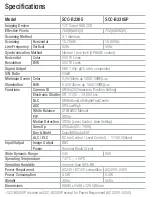
DOC ID -
1942 • Rev 03
3 / 11
Table 3: CO alarm memory indicators
CO gas level
Red light response
24-hours
On demand
(button press)
≈ 70 ppm
1 flash every 50 seconds
1 flash
≈ 150 ppm
2 flashes every 50 seconds
2 flashes
≈ 400 ppm
4 flashes every 50 seconds
4 flashes
≈ 750 ppm
4 flashes every 50 seconds
4 flashes
CO alarm location
NATIONAL FIRE PROTECTION ASSOCIATION REQUIRED
PROTECTION
For your information the National Fire Protection Association’s
Standard 720 advises as follows:
Carbon Monoxide Alarms shall be installed as follows:
1. Outside of each separate dwelling unit sleeping area in the
immediate vicinity of the bedroom.
2. On every occupiable level of a dwelling unit, including
basements but excluding attics and crawl spaces.
3. Other locations where required by applicable laws, codes,
or standards.
The equipment should be installed using wiring methods in
accordance with the National Fire Protection Association’s
Standard 72, 720. (National Fire Protection Association,
Batterymarch Park, Quincy, MA 02269).
Note
: Specific requirements for Carbon Monoxide alarm
installation vary from state to state and from region to region.
Check with your local Fire Department for current requirements
in your area.
Recommended installation location
•
Every room containing a fuel burning appliance, and
remote rooms where occupants spend a considerable
amount of time
•
In every bedroom. If the number of Carbon Monoxide
alarms to be fitted is limited, the following points should be
considered when deciding where best to fit the alarm(s)
o
Place a CO alarm in the room if there is an
appliance where people sleep.
o
Place a CO alarm in a room containing a flueless
or open-flued appliance.
o
Place an alarm in a room where the occupant(s)
spend most of their time (e.g. family room).
•
In a studio apartment, the CO alarm should be placed as
far away from the cooking appliance as possible, but near
where the person sleeps.
•
If the appliance is in a room not normally used, such as a
furnace room, the CO alarm should be placed immediately
outside the room so that the alarm is heard more easily.
Figure 1: Location of CO alarm in a room with a fuel burning
appliance
Figure 2: CO alarm in a room with sloped ceilings
Note:
The CO Alarm should be located at the high side of the room.
Figure 3: CO alarm in bedrooms and other rooms away from
appliances (i.e. at breathing level)




























